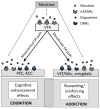Dual role of nicotine in addiction and cognition: a review of neuroimaging studies in humans
- PMID: 23474015
- PMCID: PMC3710300
- DOI: 10.1016/j.neuropharm.2013.02.015
Dual role of nicotine in addiction and cognition: a review of neuroimaging studies in humans
Abstract
Substantial evidence demonstrates both nicotine's addiction liability and its cognition-enhancing effects. However, the neurobiological mechanisms underlying nicotine's impact on brain function and behavior remain incompletely understood. Elucidation of these mechanisms is of high clinical importance and may lead to improved therapeutics for smoking cessation as well as for a number of cognitive disorders such as schizophrenia. Neuroimaging techniques such as positron emission tomography (PET), single photon emission computed tomography (SPECT), and functional magnetic resonance imaging (fMRI), which make it possible to study the actions of nicotine in the human brain in vivo, play an increasingly important role in identifying these dual mechanisms of action. In this review, we summarize the current state of knowledge and discuss outstanding questions and future directions in human neuroimaging research on nicotine and tobacco. This research spans from receptor-level PET and SPECT studies demonstrating nicotine occupancy at nicotinic acetylcholine receptors (nAChRs) and upregulation of nAChRs induced by chronic smoking; through nicotine's interactions with the mesocorticolimbic dopamine system believed to mediate nicotine's reinforcing effects leading to dependence; to functional activity and connectivity fMRI studies documenting nicotine's complex behavioral and cognitive effects manifest by its actions on large-scale brain networks engaged both during task performance and at rest. This article is part of the Special Issue Section entitled 'Neuroimaging in Neuropharmacology'.
Keywords: Addiction; Cognition; Dopamine; Nicotine; PET; SPECT; Smoking; Tobacco; fMRI.
Published by Elsevier Ltd.
Figures



Similar articles
-
Nicotinic acetylcholine receptors and nicotine addiction: A brief introduction.Neuropharmacology. 2020 Oct 15;177:108256. doi: 10.1016/j.neuropharm.2020.108256. Epub 2020 Jul 29. Neuropharmacology. 2020. PMID: 32738308 Free PMC article. Review.
-
Alpha7-nicotinic receptors modulate nicotine-induced reinforcement and extracellular dopamine outflow in the mesolimbic system in mice.Psychopharmacology (Berl). 2012 Mar;220(1):1-14. doi: 10.1007/s00213-011-2422-1. Epub 2011 Sep 8. Psychopharmacology (Berl). 2012. PMID: 21901321
-
Molecular and cellular mechanisms of action of nicotine in the CNS.Handb Exp Pharmacol. 2009;(192):173-207. doi: 10.1007/978-3-540-69248-5_7. Handb Exp Pharmacol. 2009. PMID: 19184650 Review.
-
Cognitive Effects of Nicotine: Recent Progress.Curr Neuropharmacol. 2018;16(4):403-414. doi: 10.2174/1570159X15666171103152136. Curr Neuropharmacol. 2018. PMID: 29110618 Free PMC article. Review.
-
In vivo brain imaging of human exposure to nicotine and tobacco.Handb Exp Pharmacol. 2009;(192):145-71. doi: 10.1007/978-3-540-69248-5_6. Handb Exp Pharmacol. 2009. PMID: 19184649 Free PMC article. Review.
Cited by
-
Why flavored vape products may be attractive: Green apple tobacco flavor elicits reward-related behavior, upregulates nAChRs on VTA dopamine neurons, and alters midbrain dopamine and GABA neuron function.Neuropharmacology. 2019 Nov 1;158:107729. doi: 10.1016/j.neuropharm.2019.107729. Epub 2019 Jul 29. Neuropharmacology. 2019. PMID: 31369741 Free PMC article.
-
A Working Hypothesis for the Role of the Cerebellum in Impulsivity and Compulsivity.Front Behav Neurosci. 2019 May 7;13:99. doi: 10.3389/fnbeh.2019.00099. eCollection 2019. Front Behav Neurosci. 2019. PMID: 31133834 Free PMC article.
-
The effect of e-cigarettes on cognitive function: a scoping review.Psychopharmacology (Berl). 2024 Jul;241(7):1287-1297. doi: 10.1007/s00213-024-06607-8. Epub 2024 May 10. Psychopharmacology (Berl). 2024. PMID: 38724716 Free PMC article.
-
Aberrant Spontaneous and Task-Dependent Functional Connections in the Anxious Brain.Biol Psychiatry Cogn Neurosci Neuroimaging. 2016 May;1(3):278-287. doi: 10.1016/j.bpsc.2015.12.004. Biol Psychiatry Cogn Neurosci Neuroimaging. 2016. PMID: 27141532 Free PMC article.
-
Neurobiological impact of nicotinic acetylcholine receptor agonists: an activation likelihood estimation meta-analysis of pharmacologic neuroimaging studies.Biol Psychiatry. 2015 Nov 15;78(10):711-20. doi: 10.1016/j.biopsych.2014.12.021. Epub 2015 Jan 7. Biol Psychiatry. 2015. PMID: 25662104 Free PMC article.
References
-
- Anstey KJ, von Sanden C, Salim A, O’Kearney R. Smoking as a risk factor for dementia and cognitive decline: a meta-analysis of prospective studies. Am J Epidemiol. 2007;166:367–378. - PubMed
-
- Barrett SP, Boileau I, Okker J, Pihl RO, Dagher A. The hedonic response to cigarette smoking is proportional to dopamine release in the human striatum as measured by positron emission tomography and [(11)C]raclopride. Synapse. 2004;54:65–71. - PubMed
-
- Bartal M. Health effects of tobacco use and exposure. Monaldi Arch Chest Dis. 2001;56:545–554. - PubMed
Publication types
MeSH terms
Substances
Grants and funding
LinkOut - more resources
Full Text Sources
Other Literature Sources
Medical

